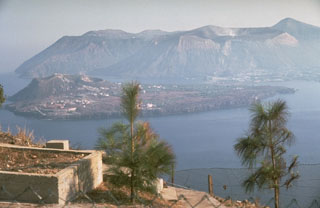Report on Vulcano (Italy) — April 1991
Bulletin of the Global Volcanism Network, vol. 16, no. 4 (April 1991)
Managing Editor: Lindsay McClelland.
Vulcano (Italy) Fumarole temperatures increase
Please cite this report as:
Global Volcanism Program, 1991. Report on Vulcano (Italy) (McClelland, L., ed.). Bulletin of the Global Volcanism Network, 16:4. Smithsonian Institution. https://doi.org/10.5479/si.GVP.BGVN199104-211050
Vulcano
Italy
38.404°N, 14.962°E; summit elev. 500 m
All times are local (unless otherwise noted)
Observations at "La Fossa" crater in recent years have included changes in fumarole temperatures and chemical compositions, ground deformation, and opening of new fractures. Data collected since a systematic surveillance program began in 1977 have allowed geologists to identify different stages during which changing contributions of magmatic gases and water caused fluctuating fumarole outputs. The interaction of heat rising from depth with shallow aquifers has produced changes in water vaporization and pressure as the heat/water ratio varied.
Only minor crater activity occurred until 1987, probably because of the constraints imposed by a limited fracture system on the thermal input. Since then, a sharp change has been observed, with ground inflation and significant increases in the maximum temperature and water concentration of emitted fluids.
In 1990, a further increase in the maximum temperature (to 620°C) and decrease in water contents of fumarole fluids were interpreted as a consequence of increased heat flow, causing significant aquifer depletion (15:08).
The most recent (April 1991) observations indicate that fumarole temperatures are again increasing, and significant vaporization as well as new inflation can be expected. Geologists noted that the long-lasting instability of La Fossa's NW sector could result in some form of collapse that could create problems for the local community.
Further References. Falsaperla, S., Frazzetta, G., Neri, G., Nunnari, G., Velardita, R., and Villari, L., 1989, Volcano monitoring in the Aeolian Islands (southern Tyrrhenian Sea): the Lipari-Vulcano eruptive complex, in Latter, J.H., ed., Volcanic Hazards: Assessment and Monitoring: Springer-Verlag, p. 339-356.
Martini, M., 1989, The forecasting significance of chemical indicators in areas of quiescent volcanism: examples from Vulcano and Phlegrean Fields (Italy), in Latter, J.H., ed., Volcanic Hazards: Assessment and Monitoring: Springer-Verlag, p. 372-383.
Martini, M., Giannini, L., Buccianti, A., Prati, F., Legittimo, P.C., Iozelli, P., and Capaccioni, B., 1991, 1980-1990: Ten years of geochemical investigation at Phlegrean Fields (Italy): Journal of Volcanology and Geothermal Research, v. 48, p. 161-171.
Martini, M., Giannini, L., and Capaccioni, B., 1991, Geochemical and seismic precursors of volcanic activity: Acta Vulcanologia, v. 1, p. 7-11.
Martini, M., Giannini, L., and Capaccioni, B., 1991, The influence of water on chemical changes of fumarolic gases: different characters and their implications in forecasting volcanic activity: Acta Vulcanologia, v. 1, p. 13-16.
Geological Summary. The word volcano is derived from Vulcano stratovolcano in Italy's Aeolian Islands. Vulcano was constructed during six stages over the past 136,000 years. Two overlapping calderas, the 2.5-km-wide Caldera del Piano on the SE and the 4-km-wide Caldera della Fossa on the NW, were formed at about 100,000 and 24,000-15,000 years ago, respectively, and volcanism has migrated north over time. La Fossa cone, active throughout the Holocene and the location of most historical eruptions, occupies the 3-km-wide Caldera della Fossa at the NW end of the elongated 3 x 7 km island. The Vulcanello lava platform is a low, roughly circular peninsula on the northern tip of Vulcano that was formed as an island beginning more than 2,000 years ago and was connected to the main island in about 1550 CE. Vulcanello is capped by three pyroclastic cones and was active intermittently until the 16th century. Explosive activity took place at the Fossa cone from 1898 to 1900.
Information Contacts: M. Martini, Univ di Firenze.

